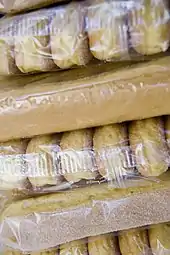Ladyfinger (biscuit)
Ladyfingers, or in British English sponge fingers (sometimes known by the Italian name savoiardi [savoˈjardi] or by the French name boudoirs [budwaʁ]), are low-density, dry, egg-based, sweet sponge cake biscuits roughly shaped like large fingers. They are a principal ingredient in many dessert recipes, such as trifles and charlottes, and are also used as fruit or chocolate gateau linings, and for the sponge element of tiramisu.[1] They are typically soaked in a sugar syrup or liqueur, or in coffee or espresso for tiramisu.[2] Plain ladyfingers are commonly given to infants, being soft enough for teething mouths, but easy to grasp and firm enough not to fall apart.
 Ladyfingers | |
| Alternative names | Savoiardi, sponge fingers, boudoir |
|---|---|
| Type | Cookie |
| Course | Dessert |
| Place of origin | Savoy |
| Region or state | Savoy |
| Created by | 15th-century official cuisine of the Duchy of Savoy (may antedate in vernacular cuisine) |
| Main ingredients | Flour, egg whites, egg yolks, sugar, powdered sugar |
History

According to a legend, ladyfingers originated in the late 15th century at the court of the Duchy of Savoy, and were created to mark the occasion of a visit by the King of France. Later, they were given the name savoiardi and recognized as an "official" court biscuit. They were particularly appreciated by the younger members of the court and offered to visitors as an example of the local cuisine. However, the first written recipe comes from the French chef Antonin Carême.[3]
Name
They have gained many regional names:
- In Argentina: vainillas
- In Australia: sponge fingers
- In Austria: Biskotte
- In Bosnia, Croatia, and Serbia: piškote/piškoti, пишкоте/пишкоти
- In Brazil: biscoito champagne (champagne biscuits)
- In Bulgaria: bishkoti (бишкоти)
- In Canada: ladyfingers
- In Chile: galletas de champaña (champagne biscuits)
- In China: shǒuzhǐ bǐnggān (手指饼干, finger biscuits)
- In Colombia: lenguas (tongues, after their form)
- In Cuba: bizcocho
- In the Czech Republic: dlouhé piškoty (long sponge biscuits) or cukrářské piškoty (confectioner's biscuits)
- In El Salvador: suspiros
- In Finland: tiramisukeksit (tiramisù biscuits), savoiardikeksit (savoiardi biscuits), and sokerikakkukeksit (sugar cake biscuits)
- In France: boudoirs or biscuits à la cuillère (spoon cookies/biscuits) or biscuits champagne
- In Germany: Löffelbiskuits (spoon cookies/biscuits)
- In Greece: savouayiár (σαβουαγιάρ, a French adaptation of the Italian name)
- In Guatemala: chiquiadores
- In Hungary: babapiskóta (baby sponge cake)
- In Indonesia: kue lidah kucing (cat's tongue cookies)
- In Iran: latifeh (لطیفه)
- In Israel: biskot (בישקוט)
- In Italy: savoiardi
- In North Macedonia: biskviti (бисквити)
- In Mexico: soletas (little soles)
- In Flanders and the Netherlands: lange vingers (long fingers)
- In Pakistan: bistiks ( بسٹیکس)
- In the Philippines: broas or broa (Spanish for some more nutritive types of bread, sometimes misspelled as brojas); variants include camachile and lengua de gato
- In Poland: kocie języczki (cats' little tongues) or biszkopty[4] (sponge cakes/biscuits)
- In Portugal: biscoitos de champanhe (champagne biscuits) or palitos la reine
- In Romania: pișcoturi
- In Russia: damskiye pal'chiki (дамские пальчики, lady's fingers)
- In Slovakia: cukrárske piškóty (Konditor's biscuits)
- In Slovenia: bebi piškoti ("baby cookies")
- In South Africa: sold as boudoir biscuits, but best known as finger biscuits
- In Spain: bizcochos de soletilla (little sole biscuits)
- In Taiwan: 手指餅乾 (finger cookies)
- In Turkey: kedi dili (cat's tongue)
- In the United Kingdom: sponge fingers, boudoir biscuits, baby biscuits, funeral biscuits, savoy biscuits, or boudoir fingers
- In the United States: ladyfingers[3]
- In (ultra)Orthodox Jewish communities in the USA a version of ladyfingers usually manufactured from a potato starch base is a popular Passover snack, in recent years many companies have taken to labeling them as babyfingers[5] instead of ladyfingers due to a sentiment popular in that community that views any public mention of ladies as immodest
- In Uruguay and Venezuela: plantillas (insoles)
- In Vietnam: bánh sâm banh, bánh săm pa (biscuits champagne)
Preparation

Like other sponge cakes, ladyfingers traditionally contain no chemical leavening agent, and rely on air incorporated into the eggs for their "sponge" texture. Some brands, though, contain ammonium bicarbonate. The egg whites and egg yolks mixed with sugar are typically beaten separately and folded together with flour. They contain more flour than the typical sponge cake. The mixture is piped through a pastry bag in short lines onto sheets,[1] giving the biscuits their notable shape.
Before baking, powdered sugar is usually sifted over the top[1] to give a soft crust. The finished ladyfingers are usually layered into a dessert such as tiramisu or trifle.
References
- The Ultimate Cookie Book. Better Homes and Gardens Ultimate Series. Houghton Mifflin Harcourt Publishing Company. 2014. p. 169. ISBN 978-0-544-33929-3. Retrieved January 29, 2017.
- Parkinson, A. (2005). Italian Desserts. A. Parkinson. p. 63. ISBN 978-1-4116-4464-9. Retrieved January 29, 2017.
- Sinclair, Charles (1 January 2009). Dictionary of Food: International Food and Cooking Terms from A to Z. A&C Black. ISBN 9781408102183 – via Google Books.
- Biszkopty (Polski) Archived 2016-03-26 at the Wayback Machine Carrefour. Poland.
- Manufacturers website example
External links
![]() Media related to Ladyfingers (biscuits) at Wikimedia Commons
Media related to Ladyfingers (biscuits) at Wikimedia Commons